Study on the Impact Damage Characteristics of Transplanting Seedlings Based on Pressure Distribution Measurement System
Abstract
:1. Introduction
2. Materials and Methods
2.1. Test Material
2.2. Seedling Impact Test System
2.3. Ultra-Thin Tactile Pressure Sensor Principle
2.4. Theoretical Analysis of the Seedling Collision Process
2.5. Orthogonal Test Design
3. Results and Discussion
3.1. Analysis of Orthogonal Experiment
3.2. High-Speed Images Analysis
3.3. Analysis of Single-Factor Experiments
3.3.1. Collision Material and Drop Height
3.3.2. Seedling Pot Size and Drop Height
3.3.3. Establishment of Damage Prediction Model
4. Conclusions
- (1)
- Based on the orthogonal tests, the influence laws of various factors on IPF and DSP were obtained. The results showed that the order of influencing factors for IPF was found to be: seedling pot size > drop height > collision material. The order of influencing factors for DSP was found to be: drop height > collision material > seedling pot size;
- (2)
- The Tekscan pressure distribution measurement system measured the change law of contact pressure distribution under significant influencing factors. The relationship between contact pressure distribution and seedling pot damage was determined. The result showed that with the increase of drop height, the pressured area between the seedling pot and the collision material increased gradually, and the high-pressure area showed a gradually increasing trend. In descending order, the pressured area of seedlings of different pot sizes was big, medium, and small. The pressured area of different materials was soil blocks, steel, and ABS plastic in descending order;
- (3)
- Linear regression models between IPF and DSP under different factors were established based on the pressured data collected by the Tekscan pressure distribution testing system, and the determination coefficients (R2) were 0.98 and 0.94, respectively.
Author Contributions
Funding
Data Availability Statement
Acknowledgments
Conflicts of Interest
References
- Hwang, S.J.; Park, J.H.; Lee, J.Y.; Shim, S.B.; Nam, J.S. Optimization of main link lengths of transplanting device of semi-automatic vegetable transplanter. Agronomy 2020, 10, 1938. [Google Scholar] [CrossRef]
- Liu, C.; Li, X.; Yue, X.; Zhao, H. Status and development trend of dry land transplanting machine in China. J. Agric. Mech. Res. 2012, 34, 249–252. [Google Scholar]
- Zhang, H.; Hu, Z.; Wu, F.; Wang, H.; Wang, J.; Cao, M. Domestic seedling transplanting machinery overview and development thinking. Jiangsu Agric. Sci. 2010, 38, 570–572. [Google Scholar]
- Han, L.; Kumi, F.; Mao, H.; Hu, J. Design and tests of a multi-pin flexible seedling pick-up gripper for automatic transplanting. Appl. Eng. Agric. 2019, 35, 949–957. [Google Scholar] [CrossRef]
- Wen, Y.; Zhang, L.; Huang, X.; Yuan, T.; Zhang, J.; Tan, Y.; Feng, Z. Design of and Experiment with Seedling Selection System for Automatic Transplanter for Vegetable Plug Seedlings. Agronomy 2021, 11, 2031. [Google Scholar] [CrossRef]
- Wang, Y.; Chen, J.; Wu, J.; Zhao, Y. Mechanics property experiment of broccoli seedling oriented to mechanized planting. Trans. Chin. Soc. Agric. Eng. 2014, 30, 1–10. [Google Scholar]
- Han, C.; Guo, H.; Yang, W. Study on characteristics of pepper plug seedling dropping. J. Agric. Mech. Res. 2015, 37, 197–200. [Google Scholar]
- Wang, H.; Zhou, Y.; Wang, P.; Hu, M. Mechanical properties of cotton bowl seedling and cotton bowl. J. Huazhong Agric. Univ. 2017, 36, 117–122. [Google Scholar]
- Han, L.; Mao, H.; Hu, J.; Mu, X.; Tian, K.; Yang, X. Experiment on mechanical property of seedling pot for automatic transplanter. Trans. Chin. Soc. Agric. Eng. 2013, 29, 24–29. [Google Scholar]
- Jorg, O.J.; Sportelli, M.; Fontanelli, M.; Frasconi, C.; Raffaelli, M.; Fantoni, G. Design, Development and Testing of Feeding Grippers for Vegetable Plug Transplanters. AgriEngineering 2021, 3, 669–680. [Google Scholar] [CrossRef]
- Ma, X.; Li, H.; Cao, W.; Yu, S.; Li, S. Optimization and experiment of working parameters of automatic seedling picking device for tomato seedlings transplanting. Trans. Chin. Soc. Agric. Eng. 2020, 36, 46–55. [Google Scholar]
- Wang, Y. Key Technologies of Vegetable Plug Seedlings Transplanting Based on Machine Vision and Simulation Test; Jilin University: Changchun, China, 2016. [Google Scholar]
- Gao, G.; Ma, S. Provement of transplanting manipulator for potted flower based on discrete element analysis and Su-field analysis. Trans. Chin. Soc. Agric. Eng. 2017, 33, 35–42. [Google Scholar]
- Benmebarek, M.A.; Movahedi Rad, M. DEM Modeling of Crushable Grain Material under Different Loading Conditions. Period. Polytech. Civ. Eng. 2021, 65, 935–945. [Google Scholar] [CrossRef]
- Zhiwei, T.; Wei, M.; Qichang, Y.; Sen, Y.; Xiangyu, G.; Famin, D. Design and Experiment of Gripper for Greenhouse Plug Seedling Transplanting Based on EDM. Agronomy 2022, 12, 1487. [Google Scholar]
- Jiang, Z.; Hu, Y.; Jiang, H.; Tong, J. Design and force analysis of end-effector for plug seedling transplanter. PLoS ONE 2017, 12, e0180229. [Google Scholar] [CrossRef] [Green Version]
- Mohamed, S.; Liu, J. Effect of Soil Moisture Content and End-Effector Speed on Pick-up Force and Lump Damage for Seedling Transplanting. AgriEngineering 2019, 1, 343–355. [Google Scholar] [CrossRef] [Green Version]
- Liu, J.; Cui, W.; Tian, D.; Ou, Y.; Zhao, H. Optimization experiment of transplanting actuator parameters based on mechanical property of seedling pot. Trans. Chin. Soc. Agric. Eng. 2016, 32, 32–39. [Google Scholar]
- Xiang, W.; Luo, X.; Wang, Y. Kinetic simulation of pot seedling by ANSYS/LS-DYNA. J. Agric. Mech. Res. 2007, 38 29, 42–44. [Google Scholar]
- Liu, Y.; Mao, H.; Li, Y.; Li, B.; Wang, T. Optimization of working parameters and experiment for basket transplanter. J. Jiangsu Univ. Nat. Sci. Ed. 2018, 39, 296–302. [Google Scholar]
- Zeng, F.; Li, X.; Bai, H.; Cui, J.; Liu, X.; Zhang, Y. Experimental Study on Pot Damage and Contact Stress Distribution Characteristics of Oil Sunflower Plug Seedlings. Appl. Sci. 2022, 12, 10889. [Google Scholar] [CrossRef]
- Bao, G.; Wang, G.; Wang, B.; Hu, L.; Xu, X.; Shen, H.; Ji, L. Study on the drop impact characteristics and impact damage mechanism of sweet potato tubers during harvest. PLoS ONE 2021, 16, e0255856. [Google Scholar] [CrossRef] [PubMed]
- Xie, S.; Wang, C.; Deng, W. Model for the prediction of potato impact damage depth. Int. J. Food Prop. 2018, 21, 2517–2526. [Google Scholar] [CrossRef]
- Lewis, R.; Yoxall, A.; Marshall, M.B.; Canty, L.A. Characterising pressure and bruising in apple fruit. Wear Int. J. Sci. Technol. Frict. Lubr. Wear 2008, 264, 37–46. [Google Scholar] [CrossRef] [Green Version]
- Lu, F.; Ishikawa, Y.; Kitazawa, H.; Satake, T. Measurement of impact pressure and bruising of apple fruit using pressure-sensitive film technique. J. Food Eng. 2010, 96, 614–620. [Google Scholar] [CrossRef] [Green Version]
- Xu, H.; Zhao, Y.; Dai, H.; Zhang, X.; Yao, D.; Liu, J. Experimental Study on Damage Characteristics of Loquat Fruit. J. Agric. Mech. Res. 2021, 43, 106–112. [Google Scholar]
- Komarnicki, P.; Stopa, R.; Kuta, Ł.; Szyjewicz, D. Determination of apple bruise resistance based on the surface pressure and contact area measurements under impact loads. Comput. Electron. Agric. 2017, 142, 155–164. [Google Scholar] [CrossRef]
- Stopa, R.; Szyjewicz, D.; Komarnicki, P.; Kuta, Ł. Limit values of impact energy determined from contours and surface pressure distribution of apples under impact loads. Comput. Electron. Agric. 2018, 154, 1–9. [Google Scholar] [CrossRef]
- DeMarco, A.; Rust, D.; Bachus, K. Measuring contact pressure and contact area in orthopedic applications: Fuji film vs. Tekscan. Trans. Orthop. Res. Soc. 2000, 25, 518. [Google Scholar]
- Hu, Q.; Miao, Q.; Wang, Y. Mechanical and biological characteristics analysis of mechanically transplanted rapeseed substrate block seedlings. Trans. Chin. Soc. Agric. Eng. 2019, 35, 58–65. [Google Scholar]
- Wang, Y.; Yu, H. Experiment and analysis of impact factors for soil matrix intact rate of manipulator for picking-up plug seedlings. Trans. Chin. Soc. Agric. Eng. 2015, 31, 65–71. [Google Scholar]
- Herold, B.; Geyer, M.; Studman, C.J. Fruit contact pressure distributions—Equipment. Comput. Electron. Agric. 2001, 32, 167–179. [Google Scholar] [CrossRef]
- Yang, L.; Zhang, Y.; Liu, D.; Xu, B.; Liu, C. Early recognition for dairy cow lameness based on pressure distribution measurement system. Trans. Chin. Soc. Agric. Mach. 2016, 47, 426–432. [Google Scholar]
- Li, J.; Xie, S.; Liu, F.; Guo, Y.; Liu, C.; Shang, Z.; Zhao, X. Calibration and Testing of Discrete Element Simulation Parameters for Sandy Soils in Potato Growing Areas. Appl. Sci. 2022, 12, 10125. [Google Scholar] [CrossRef]
- Yu, Z.; Hu, Z.; Peng, B.; Gu, F.; Yang, L.; Yang, M. Experimental determination of restitution coefficient of garlic bulb based on high-speed photography. Int. J. Agric. Biol. 2021, 14, 81–90. [Google Scholar] [CrossRef]
- He, S.W.; Wu, Y.; Li, X. Theoretical Model On Elastic-Plastic Granule Impact. Eng. Mech. 2008, 25, 19–24. [Google Scholar]
- Liu, Y.; Mao, H.; Wang, T.; Li, B.; Li, Y. collision optimization and experiment of tomato plug seedling in basket-type transplanting mechanism. Trans. Chin. Soc. Agric. Mach. 2018, 49, 143–151. [Google Scholar]
- Sun, H.; Wu, J.; Feng, Z.; Wang, Z. Contact Stress of Drop Impact to Corrugated Board and Damage Predication for Korla Pear. Mod. Food Sci. Technol. 2014, 30, 48–52. [Google Scholar]
- Feng, B.; Sun, W.; Shi, L.; Sun, B.; Zhang, T.; Wu, J. Determination of restitution coefficient of potato tubers collision in harvest and analysis of its influence factors. Trans. Chin. Soc. Agric. Eng. 2015, 31, 65–71. [Google Scholar]
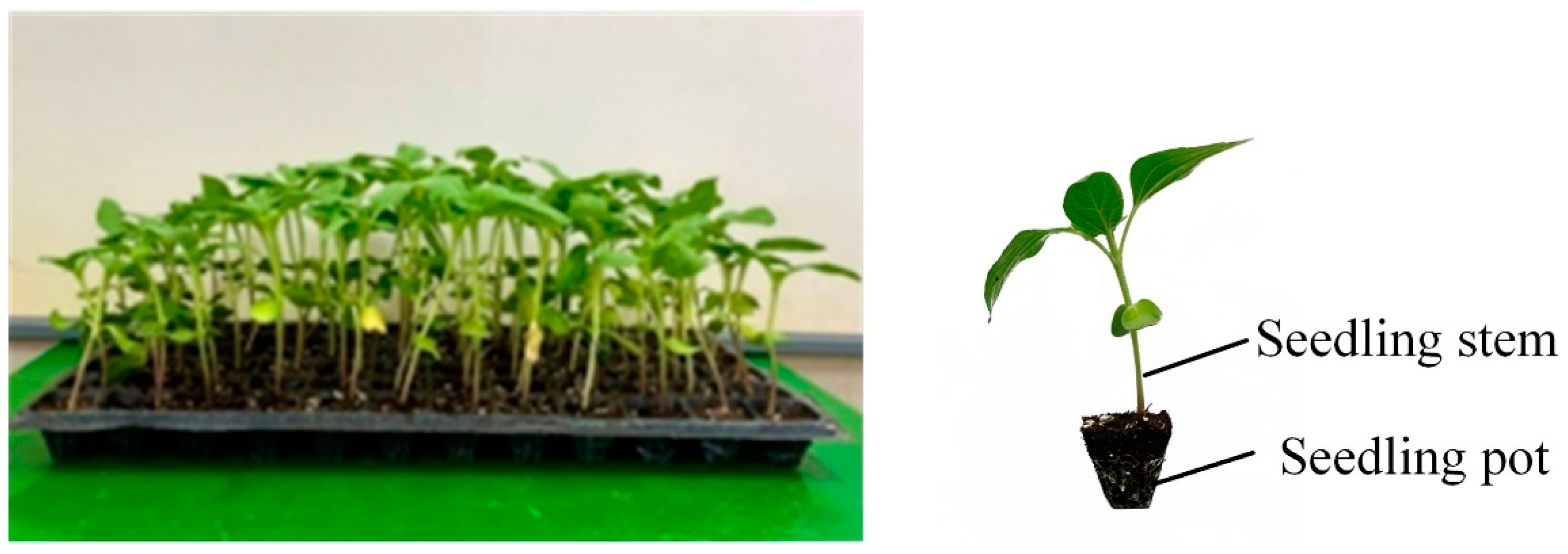
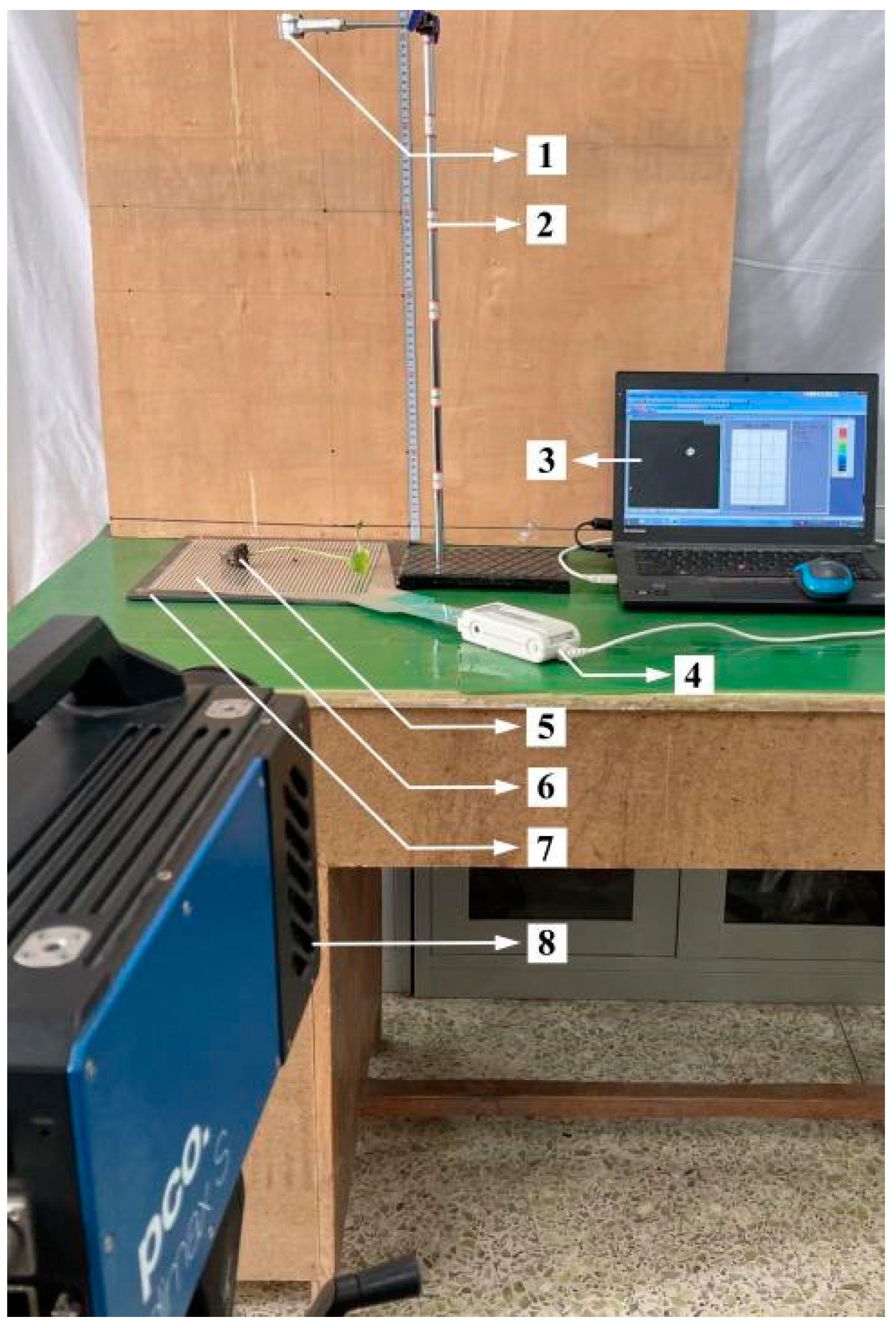

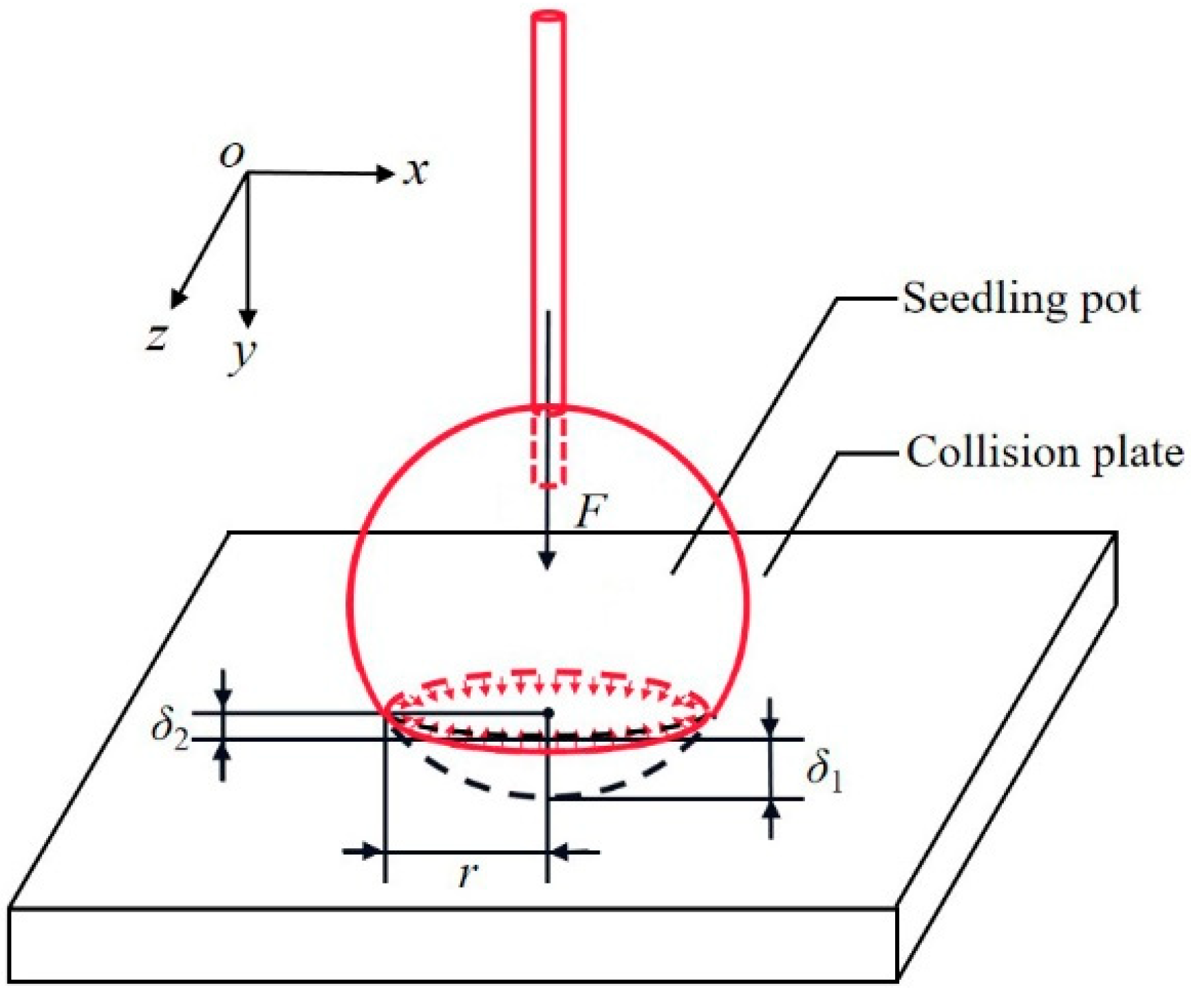
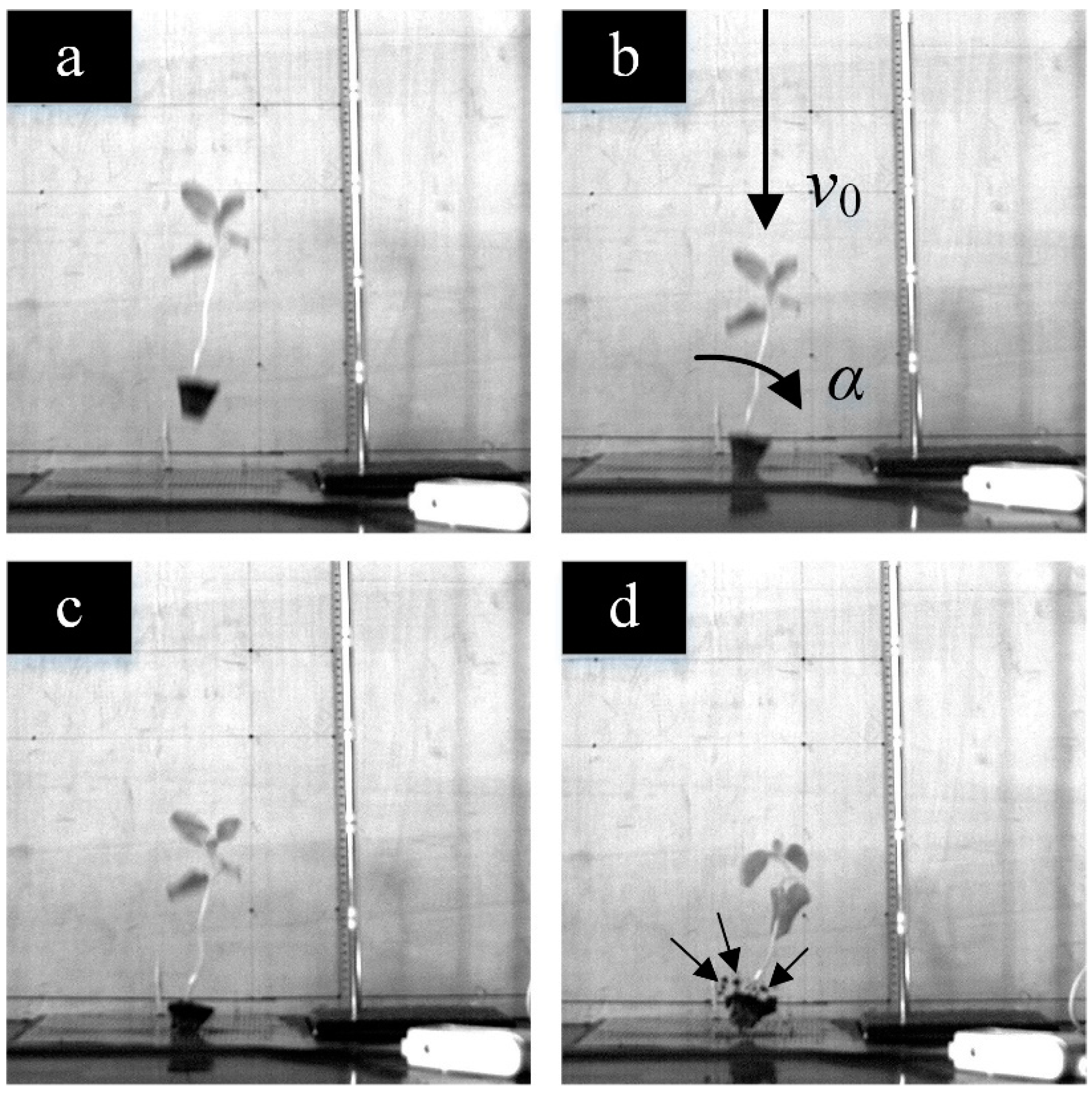

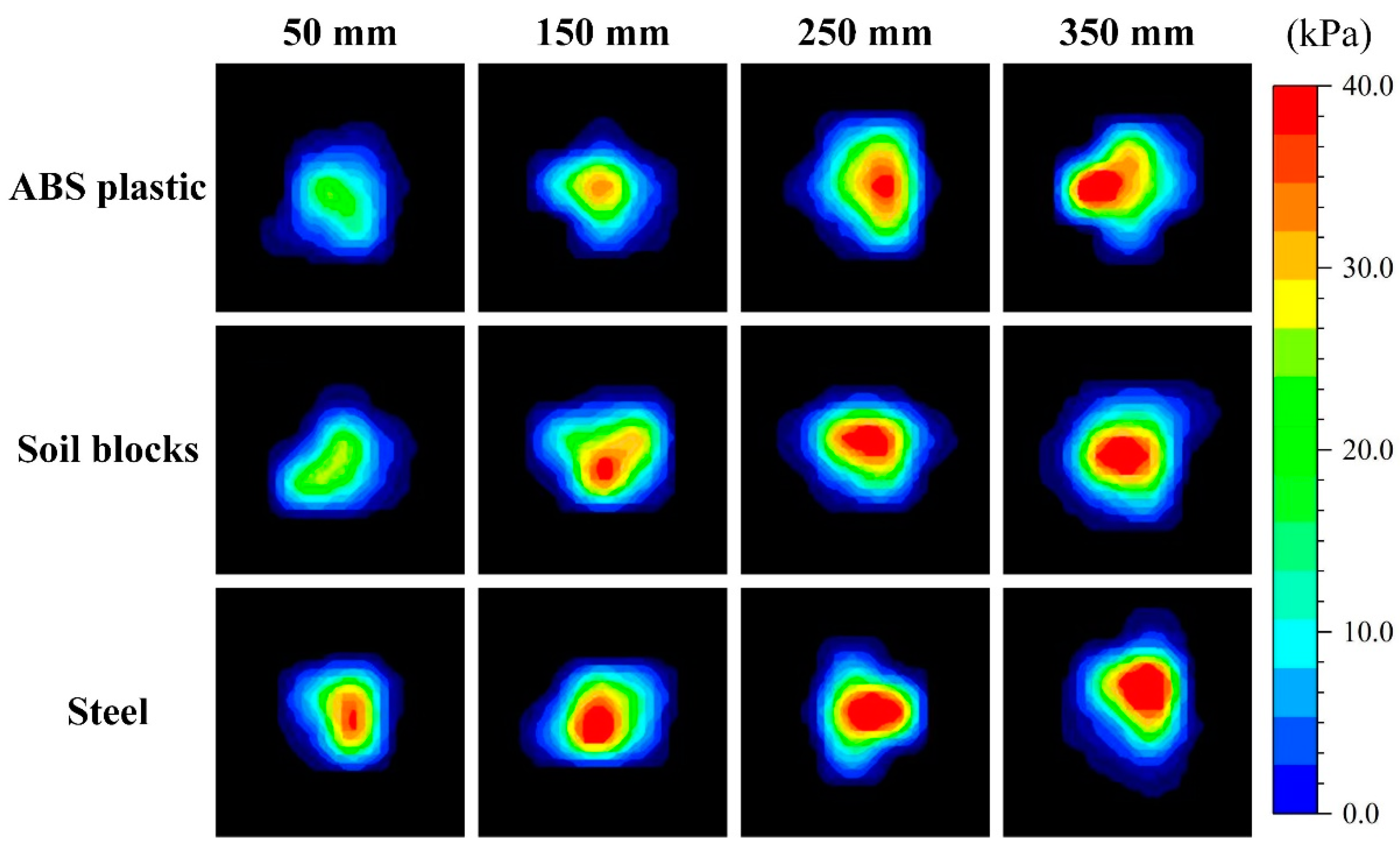

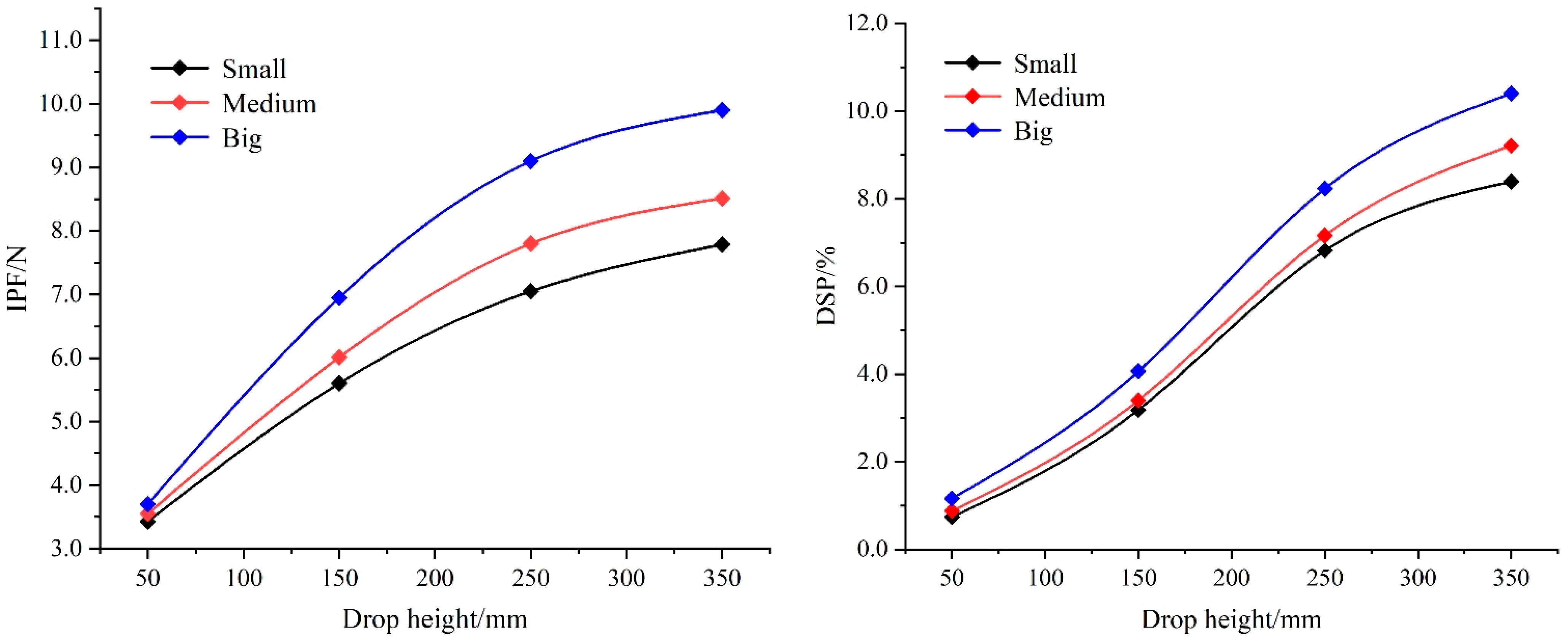


| Materials | Density/(g/cm3) | Elastic Modulus/Gpa | Poisson’s Ratio |
|---|---|---|---|
| Steel | 7.85 | 182 | 0.3 |
| ABS plastic | 1.07 | 2.2 | 0.39 |
| Soil blocks | 1.45 | 0.00284 | 0.42 |
| Level | Factors | ||
|---|---|---|---|
| Collision Material (A) | Drop Height (B)/mm | Seedling Pot Size (C) | |
| 1 | Steel | 150 | Small |
| 2 | ABS plastic | 250 | Medium |
| 3 | Soil blocks | 350 | Big |
| Test Number | Collision Material (A) | Drop Height (B)/mm | Seedling Pot Size (C) | IPF/N | DSP/% | |
|---|---|---|---|---|---|---|
| 1 | 1 | 1 | 1 | 4.60 | 3.18 | |
| 2 | 1 | 2 | 2 | 8.40 | 7.16 | |
| 3 | 1 | 3 | 3 | 10.58 | 10.40 | |
| 4 | 2 | 1 | 2 | 5.12 | 2.45 | |
| 5 | 2 | 2 | 3 | 7.65 | 5.51 | |
| 6 | 2 | 3 | 1 | 5.42 | 5.11 | |
| 7 | 3 | 1 | 3 | 6.50 | 4.09 | |
| 8 | 3 | 2 | 1 | 5.28 | 4.80 | |
| 9 | 3 | 3 | 2 | 8.06 | 8.63 | |
| IPF | k1 | 7.86 | 5.41 | 5.10 | ||
| k2 | 6.06 | 7.11 | 7.19 | |||
| k3 | 6.61 | 8.02 | 8.24 | |||
| R | 1.80 | 2.61 | 3.14 | |||
| DSP | k1 | 6.91 | 3.24 | 4.36 | ||
| k2 | 4.36 | 5.82 | 6.08 | |||
| k3 | 5.84 | 8.05 | 6.67 | |||
| R | 2.56 | 4.81 | 2.30 | |||
| Factors | Sum of Squares | Degree of Freedom | Mean Squares | p-Value | |
|---|---|---|---|---|---|
| IPF | A | 5.085 | 2 | 2.542 | 0.019 |
| B | 10.559 | 2 | 5.279 | 0.009 | |
| C | 15.365 | 2 | 7.683 | 0.006 | |
| Error | 0.098 | 2 | 0.049 | ||
| DSP | A | 9.889 | 2 | 4.944 | 0.029 |
| B | 34.721 | 2 | 17.360 | 0.009 | |
| C | 8.596 | 2 | 4.298 | 0.034 | |
| Error | 0.299 | 2 | 0.150 | ||
Publisher’s Note: MDPI stays neutral with regard to jurisdictional claims in published maps and institutional affiliations. |
© 2022 by the authors. Licensee MDPI, Basel, Switzerland. This article is an open access article distributed under the terms and conditions of the Creative Commons Attribution (CC BY) license (https://creativecommons.org/licenses/by/4.0/).
Share and Cite
Bai, H.; Li, X.; Zeng, F.; Cui, J.; Zhang, Y. Study on the Impact Damage Characteristics of Transplanting Seedlings Based on Pressure Distribution Measurement System. Horticulturae 2022, 8, 1080. https://doi.org/10.3390/horticulturae8111080
Bai H, Li X, Zeng F, Cui J, Zhang Y. Study on the Impact Damage Characteristics of Transplanting Seedlings Based on Pressure Distribution Measurement System. Horticulturae. 2022; 8(11):1080. https://doi.org/10.3390/horticulturae8111080
Chicago/Turabian StyleBai, Hongbin, Xuying Li, Fandi Zeng, Ji Cui, and Yongzhi Zhang. 2022. "Study on the Impact Damage Characteristics of Transplanting Seedlings Based on Pressure Distribution Measurement System" Horticulturae 8, no. 11: 1080. https://doi.org/10.3390/horticulturae8111080






